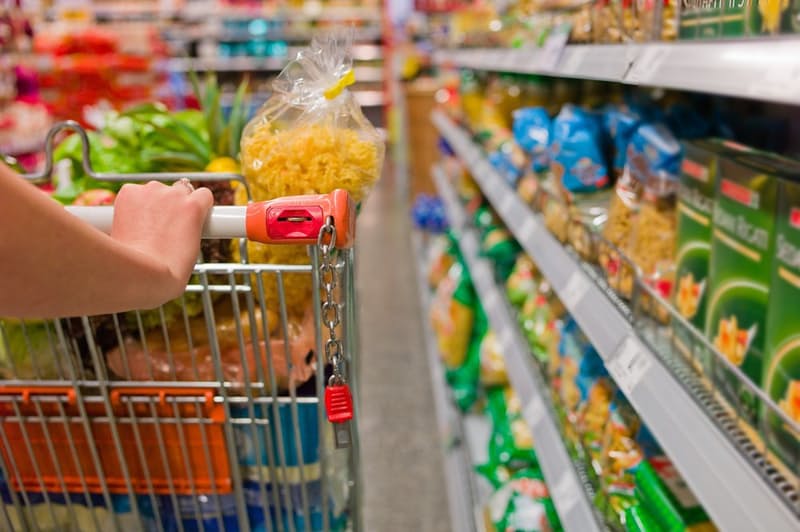Fix Your Grocery List: 10 Ways You’re Wasting Money on Food

The average American family spends $4,000 per year on groceries, according to data from the Bureau of Labor Statistics, or about $333 per month. Yet for many, food eats up even more of the household budget, often due to sloppy shopping mistakes like giving in when the kids beg for candy, tossing frozen meals in your cart because you don’t have time to cook, and grabbing containers of single-serve snacks and pre-cut veggies to save time. By the time you get to the checkout, you’re looking at a three-figure total and still don’t seem to have anything to make for dinner.
Bad shopping habits are one reason the average U.S. household throws away $640 worth of food every year, according to a survey by the American Chemistry Council. And that just counts the soured milk that gets poured down the drain or the moldy peaches we toss in the trash. Americans waste even more money by scooping up over-priced items, ignoring sales, not shopping around at different stores, and neglecting to use coupons, according to consumer experts.
“It seems like a pain to cut coupons or go to multiple stores or even plan out your meals,” Erin Durkin, a certified financial planner and director of financial planning at EP Wealth Advisors in Torrance, California, told The Cheat Sheet. But such moves really can pay off, as Durkin has learned from experience. “It ultimately does save money and has made my refrigerator way less crowded with food that I will eventually have to throw out because I didn’t eat it or bought too much.”
Think you’re a smart shopper? Check out these 10 ways you may be wasting money on food at the grocery store.
1. Not making a list
Grocery shopping without a list is one of the biggest money mistakes you can make. “If you go into the grocery store without a plan, you’re more likely to walk out with items you wouldn’t otherwise purchase,” Kendal Perez of Coupon Sherpa. If a paper list is too much trouble, try apps like Out of Milk and Grocery IQ, which make it easier to keep track of what you need and locate local deals. The latter is key to saving even more money at the store.
“Your grocery list should be composed of products featured in the store’s weekly sales ad,” Perez said. “Planning meals around what’s on sale is key to saving money on food and reducing your overall grocery budget.”
2. Hitting every aisle
A slow, methodical trek through the grocery store can backfire if you’re not careful.
“Don’t go down an aisle where you don’t need anything — it can only lead to overbuying,” David Bakke, a consumer expert with Money Crashers, said.
Instead of swinging through every section, review your shopping list, then bypass any part of the supermarket that doesn’t have items you need. You’re less likely to fill your cart with chips or expensive frozen meals if you don’t walk past them in the first place.
3. Shopping on the wrong day of the week
Time your shopping to coincide with your store’s weekly sales. Often, these kick off on Wednesday and sometimes will overlap with the previous week’s deals, so you can double-up on bargains. Shopping on the day the sales starts ensures you can snag any bargains before products sell out. If an item you really want is out of stock, ask for a rain check, Perez advised.
One of the worst days of the week to shop is Sunday, according to an analysis by mobile shopping app Ibotta. Ice cream, snacks, and cleaning products are all more expensive at the start of the week, their analysis found.
4. Shopping at the wrong time of day
You probably know that shopping when you’re hungry or stressed is a bad idea. Hit the store when your stomach’s rumbling or after a long, tough day at work and you’re more likely to fill your cart with expensive impulse purchases. Plus, crowded stores can lead to a get-in and get-out attitude, which “leaves little time for comparing prices or checking store apps for digital coupons,” Perez said.
Shopping when your stomach is full and you’re not in a rush isn’t the only time when the way you shop can affect how much you pay. Head to the supermarket just before closing and you could snap up deals on soon-to-be-discarded items.
“If you go at the end of the day, you can oftentimes find manager’s specials on meats — buy one get one free, 50% off, etcetera,” Durkin said. Fill your freezer with the discounted meats and you can eat well for a fraction of what you’d normally pay.
5. Always buying in bulk
“Buy 10 and save” deals are tempting, but stocking up on large quantities of an item or automatically reaching for the bigger container because it has a lower per-ounce price isn’t always a savvy move.
“Buying in bulk can be a money saver as long as you’ll use the item before it expires. Buying 100 ounces of ketchup at once might backfire on you,” Bakke said. (For reference, an opened container of ketchup is good for four to six months, according to Real Simple; after that, it might start to taste a bit off.)
6. Only shopping at one store
“Loyalty to just one store will cost you in most cases,” Perez said. To get the most for your money, it’s best to shop around. For Perez and her husband, that means hitting a warehouse club like Costco, which has good deals on usually pricey items like maple syrup, butter, and avocado oil. Walmart is their go-to for household items like toiletries, and Sprouts is where they shop for produce.
“Knowing which stores have the best prices on the items you buy is key to saving money on groceries,” consumer expert Andrea Woroch said. “Personal-care products, for example, are almost always better priced at Walmart or Target compared to grocery stores, while drugstores often have big savings on cereal when you include their loyalty program discounts. By conducting a bit of research on who has the best prices for the products you buy most, you can cut your grocery bill significantly.”
7. Passing on the store brands
Only buying name-brand products is a sure-fire way to run up your grocery bill if you’re not careful. “Try the store brands of your favorite items. It’s not like when we were kids and the ‘generic’ brands were all horrible quality,” Ken Immer, the president and chief culinary officer of Culinary Health Solutions, said.
“Many name brands are actually packing their same products under store labels with the same quality standards and a lower price,” he added. If a generic product’s packaging looks similar to the national or name-brand, that’s a good sign it’s made by the same manufacturer, Immer said. If you can’t bring yourself to give up your name-brand favorites, keep an eye out for coupons to help you save.
8. Only shopping at eye-level
Grabbing the first package of coffee or box of cereal you see is a mistake, say consumer experts. Stores put the pricier items at eye-level in the hopes you’ll grab them without scanning the shelves for a better deal. The same goes for end-caps, or the displays at the end of the aisle.
“The best bargains are closest to the floor, so get your exercise and bend down,” Jamie Novak, author of Stop Throwing Money Away, said. “Cheaper items are always farthest right on the shelf, so keep going down the aisle until you get to the end.”
9. Not shopping the sales cycles
You know canned pumpkin will be on sale in the fall and chocolate is cheaper around Valentine’s Day. But those aren’t the only seasonal sales to be aware of. “There are a lot of other seasonal items that go on sale during months you may not expect, like oatmeal in January, sodas in July, and peanut butter in September,” Nedalee Thomas, a frugal living expert and founder of Princess Power, said.
Stores also mark down items every 6 to 12 weeks as they restock the shelves, Thomas explained. Every item has its own cycle, and by tracking the prices of the items you buy most frequently, you can identify the weeks when your favorite foods will be on sale and plan to stock up then. “With some time and practice, you can learn how to keep tabs on the best deals,” Thomas said.
10. Not paying attention at the register
Mistakes can happen when cashiers scan the items in your cart, and these may cost you money. Big-box store Target was recently ordered to pay a $4 million fine after an investigation revealed that items sometimes rang up at higher-than-advertised prices.
“Watch as your items are rung up,” Novak said. “Overly sensitive pricing guns can inadvertently scan an item twice. A cashier can accidentally charge you for expensive curly parsley when what’s really in the bag is the less expensive flat leaf parsley.”
Original post from www.cheatsheet.com








